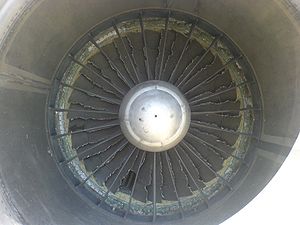 |
| English: View of Fan blades of JT8D Jet engine after a bird strike Türkçe: Bir JT8D Jet motorunun Kuş çarpması neticesinde hasara uğramış fan pallerinin görünümü (Photo credit: Wikipedia) |
 |
| English: Transonic tunnel fan blades, with light reflections. Grady McCoy is shown standing next to the fan blades. (Photo credit: Wikipedia) |
 |
| English: View of Fan blades of JT8D Jet engine after a bird strike Türkçe: Bir JT8D Jet motorunun Kuş çarpması neticesinde hasara uğramış fan pallerinin görünümü (Photo credit: Wikipedia) |
 |
| Messed up fan blades. (Repairing a broken mixer) (Photo credit: mskogly) |
Airfoil fan blades provide efficiency and low noise using classic airfoil design
Airfoil impellers have a round leading edge, a sharp trailing edge, and in profile or cross section. As air approaches the blade’s leading edge, the stream splits and travels above and below the blade. Air is deflected across the convex curve along the top of the blade and along the flat or concave curve on the bottom of the blade, and flows downward over the sharp trailing edge as it leaves the blade.
According to Bernoulli’s Principle, the faster moving air across the top of the blade creates less pressure than the slower moving air on the bottom of the blade. This creates lift in an airplane wing or airflow in an impeller. Airfoil impellers function just like a series of small airplane wings attached to a hub, with one notable exception. In axial fans, the airfoil’s twisted design ensures that the incident angle between the airfoil and the airflow is constant along the blade length, giving a uniform blade loading for high efficiency, low noise fans.
Most efficient design in optimized conditions
- Twisting the blade reduces vortex shedding along the profile
- Airfoil blade provides low power consumption
- Cooling tower fans, radiator fans, HVAC fans, refrigeration fans
- Diameter range of 8-108 inches
Multi-Wing’s airfoil design has a broad operating range, making it suitable for everything from the most demanding engine-cooling applications to essentially any ventilation requirement. Airfoil fans may be configured as either blowers or suckers, and the blades may also have varying pitch angles to control air volume. The airfoil’s low power consumption saves power while reducing noise, making it a high efficiency solution for a spectrum of cooling applications.
The high efficiency blade design has also made Multi-Wing’s airfoil profiles a great answer for the challenges of the Tier IV emissions standards. The 4Z, 5Z and 6W blades each can be tailored as an engine cooling fan, a condenser fan, a radiator fan or an oil cooler fan. In fact, select airfoil fans have the narrow axial depth necessary to provide the required cooling performance in the tight engine compartments that result from Tier IV. As one of the nation’s premier heat transfer products firms noted in their seminars on Tier IV requirements, “Outside of the core, the fan is the most important component of the cooling package.”






